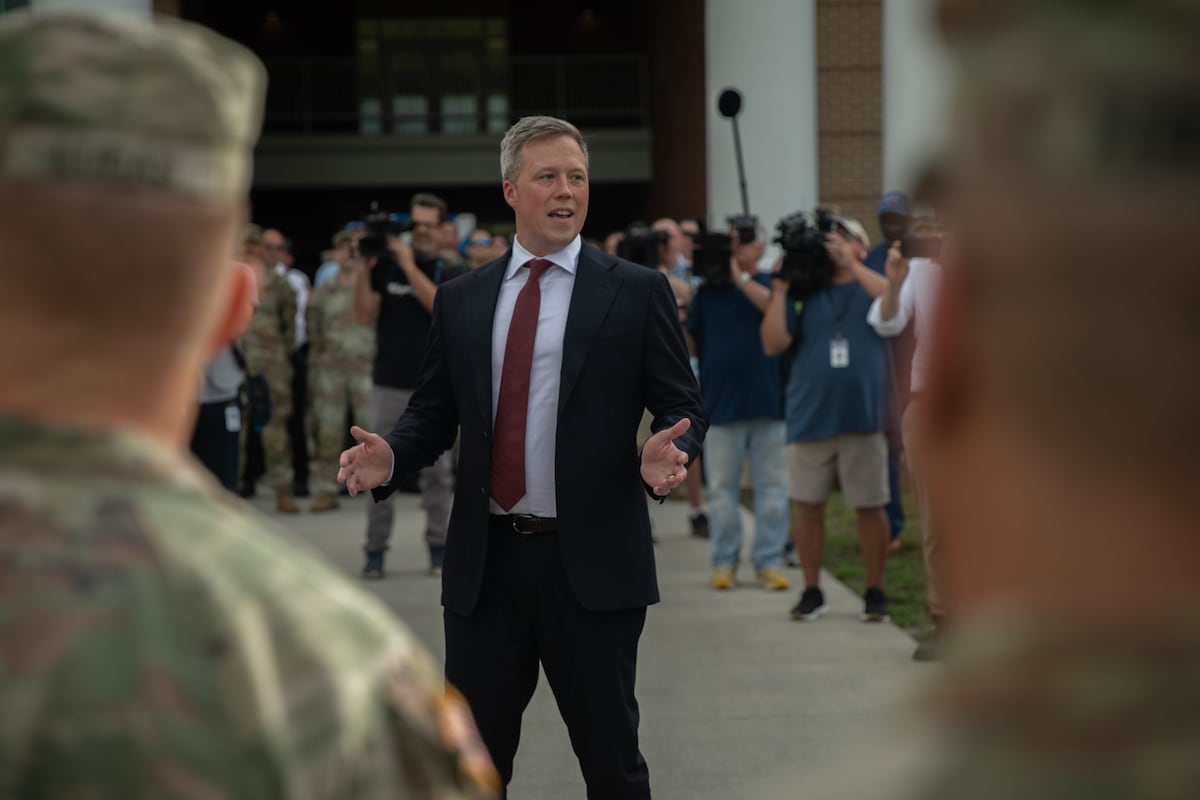In perhaps a first for the annual meeting of the staid U.S. Army Association in Washington, the Secretary of the Army opened the conference with an F-bomb.
Dan Driscoll, who has been the Army's civilian leader since February, announced major upcoming changes to Army purchasing, parts repairs and technology adoption in a fiery address in which he accused contractors of corruption and stressed that soldiers' lives were at stake.
“We can’t wait to innovate until Americans die on the battlefield,” Driscoll said. “We must act now to empower our soldiers. Our window of opportunity for change is now, and we have a plan to do it. We will lead the way with innovation and win with silicon and software, not with the blood and bodies of our soldiers.”
Driscoll took the stage after an AI-generated video montage of soldiers and Army equipment – a display he said highlighted the technological gap between outdated technologies and new capabilities that the Army had yet to overcome.
“What we face now, here in 2025, is a turning point,” he said. “For our Army to rise to this moment, every single person, especially those attending this conference, must be able to answer “yes” to a very simple question: Am I focusing my energy and effort on ensuring Soldiers are ready to fight and win our nation’s wars? Because every minute we don't do this, we are putting the soldiers' lives at risk. Our actions today will determine the fate of our future army.”
Coming changes, he said, include a new system that will consolidate units that purchase Army equipment into a single organization reporting directly to Army leadership and dramatically shorten the contract cycle from 12 to 18 months.
“We will completely destroy the system that has held the army back and kept it at the top for decades [contractors’] “We will break down barriers until we measure acquisitions not in years and billions, but in months and thousands.”
Driscoll criticized the Army for relying on outdated equipment, pointing to a photo that showed a soldier born in 2004 working on a computer system that was deployed in 1995, a decade before his birth.
“Now Ukraine updates its drone software every few weeks,” he said. “It is absolutely incomprehensible that we send soldiers to war with 30-year-old, outdated systems. This is the tipping point where we turn everything around.”
“Clear failures” such as the Boeing-Sikorsky RAH-66 Comanche helicopter (discontinued in 2004), the XM2001 Crusader self-propelled howitzer (discontinued in 2002) and the M10 Booker light tank (discontinued in 2002) have contributed to the loss of public trust and cost billions, he said, while leaving troops without the modern equipment left behind that they need.
“You have been abandoned,” Driscoll said in a direct address to the soldiers present. “You have fought, deployed, trained and prepared for years, and you have always supported each other, but unfortunately your civilian leadership has not always done the same for you.”
Driscoll also brought aircraft parts to the stage: a fin for a UH-60 Black Hawk's external fuel tank and a tiny Black Hawk screen control knob. The parts, he said, could be 3D printed to a higher quality for about $3,000 or $60, respectively, but to completely replace the assembly from the manufacturer would cost $14,000 or $47,000. That amounted to $180,000 in unnecessary Army spending each month and months of delays, Driscoll said, underscoring the Army's need to secure the right to repair its own equipment without losing the manufacturer's support. Driscoll ruled earlier this year that current and future Army contracts include that right.
“Because of this, your tank, howitzer or vehicle sits in the fleet and you cannot train for combat with it. And if the right to repair is bad in garrison, it will be much worse in contested Indo-Pacific logistics,” he said. With accelerated efforts to deploy advanced manufacturing capabilities, including 3D printing, across the Army, he said, “Soldiers will be able to download the schematic, fabricate it and install everything in the field.”
He pointed to other “disruptive” initiatives on display at the show, including a “Shark Tank”-like program to provide venture capital for Army technology initiatives, campus-style dining facilities and the introduction of 3D-printed concrete structures to reduce construction costs.
Driscoll served as an Army officer from 2007 to 2011, earned Ranger status and was deployed to Iraq. After moving from there into law and then into investment banking and venture capital, where he served as chief operating officer of Flex Capital, among other roles, Driscoll said he could “unequivocally say that the Silicon Valley approach is absolutely ideal for the Army.”
“We will train our system to act quickly,” he said. “And soon Ukraine will not be the only Silicon Valley of warfare.”
